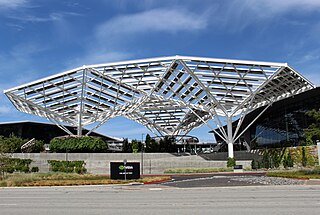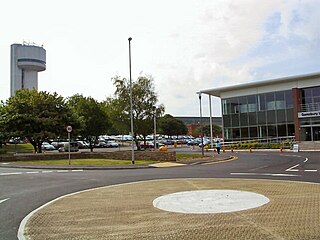
Nvidia Corporation is an American multinational corporation and technology company headquartered in Santa Clara, California, and incorporated in Delaware. It is a software and fabless company which designs and supplies graphics processing units (GPUs), application programming interfaces (APIs) for data science and high-performance computing, as well as system on a chip units (SoCs) for mobile computing and the automotive market. Nvidia is also a dominant supplier of artificial intelligence (AI) hardware and software.

SoftBank Group Corp. is a Japanese multinational investment holding company headquartered in Minato, Tokyo, Japan which focuses on investment management. The group primarily invests in companies operating in technology that offer goods and services to customers in a multitude of markets and industries ranging from the internet to automation. With over $100 billion in capital at its onset, SoftBank's Vision Fund is the world's largest technology-focused venture capital fund. Fund investors included sovereign wealth funds from countries in the Middle East.

David A. Bader is a Distinguished Professor and Director of the Institute for Data Science at the New Jersey Institute of Technology. Previously, he served as the Chair of the Georgia Institute of Technology School of Computational Science & Engineering, where he was also a founding professor, and the executive director of High-Performance Computing at the Georgia Tech College of Computing. In 2007, he was named the first director of the Sony Toshiba IBM Center of Competence for the Cell Processor at Georgia Tech.
The N8 Research Partnership is a partnership created in 2006 of the eight most research-intensive universities in Northern England – Durham, Lancaster, Leeds, Liverpool, Manchester, Newcastle, Sheffield and York. The N8 Research Partnership aims to maximise the impact of this research base by identifying and co-ordinating powerful research teams and collaborations across the North of England. Collectively, the N8 universities undertake more than £650 million of research income per annum and employ over 18,000 academic staff. The N8 Research Partnership also works closely with industry.
The Texas Advanced Computing Center (TACC) at the University of Texas at Austin, United States, is an advanced computing research center that is based on comprehensive advanced computing resources and supports services to researchers in Texas and across the U.S. The mission of TACC is to enable discoveries that advance science and society through the application of advanced computing technologies. Specializing in high-performance computing, scientific visualization, data analysis and storage systems, software, research and development, and portal interfaces, TACC deploys and operates advanced computational infrastructure to enable the research activities of faculty, staff, and students of UT Austin. TACC also provides consulting, technical documentation, and training to support researchers who use these resources. TACC staff members conduct research and development in applications and algorithms, computing systems design/architecture, and programming tools and environments.

Arm Holdings plc is a British semiconductor and software design company based in Cambridge, England, whose primary business is the design of central processing unit (CPU) cores that implement the ARM architecture family of instruction sets. It also designs other chips, provides software development tools under the DS-5, RealView and Keil brands, and provides systems and platforms, system-on-a-chip (SoC) infrastructure and software. As a "holding" company, it also holds shares of other companies. Since 2016, it has been majority owned by Japanese conglomerate SoftBank Group.

Mellanox Technologies Ltd. was an Israeli-American multinational supplier of computer networking products based on InfiniBand and Ethernet technology. Mellanox offered adapters, switches, software, cables and silicon for markets including high-performance computing, data centers, cloud computing, computer data storage and financial services.

Sqrrl Data, Inc. is an American company founded in 2012 that markets software for big data analytics and cyber security. The company has roots in the United States Intelligence Community and National Security Agency. Sqrrl was involved in the creation of, and actively contributes to Apache Accumulo and other related Apache projects. Sqrrl’s primary product is its threat hunting platform, designed for active detection of advanced persistent threats.

Nvidia Tesla is the former name for a line of products developed by Nvidia targeted at stream processing or general-purpose graphics processing units (GPGPU), named after pioneering electrical engineer Nikola Tesla. Its products began using GPUs from the G80 series, and have continued to accompany the release of new chips. They are programmable using the CUDA or OpenCL APIs.

Pascal is the codename for a GPU microarchitecture developed by Nvidia, as the successor to the Maxwell architecture. The architecture was first introduced in April 2016 with the release of the Tesla P100 (GP100) on April 5, 2016, and is primarily used in the GeForce 10 series, starting with the GeForce GTX 1080 and GTX 1070, which were released on May 27, 2016, and June 10, 2016, respectively. Pascal was manufactured using TSMC's 16 nm FinFET process, and later Samsung's 14 nm FinFET process.

Volta is the codename, but not the trademark, for a GPU microarchitecture developed by Nvidia, succeeding Pascal. It was first announced on a roadmap in March 2013, although the first product was not announced until May 2017. The architecture is named after 18th–19th century Italian chemist and physicist Alessandro Volta. It was Nvidia's first chip to feature Tensor Cores, specially designed cores that have superior deep learning performance over regular CUDA cores. The architecture is produced with TSMC's 12 nm FinFET process. The Ampere microarchitecture is the successor to Volta.

The Hartree Centre is a high performance computing, data analytics and artificial intelligence (AI) research facility focused on industry-led challenges. It was formed in 2012 at Daresbury Laboratory on the Sci-Tech Daresbury science and innovation campus in Cheshire, UK. The Hartree Centre is part of the Science and Technology Facilities Council (STFC) which itself is part of United Kingdom Research and Innovation (UKRI).

SQream is a relational database management system (RDBMS) that uses graphics processing units (GPUs) from Nvidia. SQream is designed for big data analytics using the Structured Query Language (SQL).
MiTAC Holdings Corporation was formed on September 12, 2013, through a stock swap from MiTAC International Corp. As part of a restructuring aimed at future operational objectives, the Group established MiTAC Computing Technology Corporation on September 1, 2014, to focus on designs and manufactures servers for data centers and enterprises, offering solutions from edge to cloud computing, including hyperscale data centers, AI/HPC systems, and energy-efficient technologies like liquid cooling.

PICO is an Intel Cluster installed in the data center of Cineca. PICO is intended to enable new "BigData" classes of applications, related to the management and processing of large quantities of data, coming both from simulations and experiments. The cluster is made of an Intel NeXtScale server, designed to optimize density and performance, driving a large data repository shared among all the HPC systems in Cineca.
HEAVY.AI is an American-based software company, that uses graphics processing units (GPUs) and central processing units (CPUs) to query and visualize big data. The company was founded in 2013 by Todd Mostak and Thomas Graham and is headquartered in San Francisco, California.
Keno Fischer is a German computer scientist known for being a core member implementing the Julia programming language in Windows. He is an alumnus of Harvard for both his BA and MA. He works at Julia Computing, which he co-founded with Julia co-creators, Alan Edelman, Jeff Bezanson, Stefan Karpinski, Viral B. Shah and Deepak Vinchhi. He received a B.A. in mathematics and physics from Harvard in 2016, and he completed a Master of Arts in Physics also from Harvard in 2016.

Cerebras Systems Inc. is an American artificial intelligence (AI) company with offices in Sunnyvale, San Diego, Toronto, and Bangalore, India. Cerebras builds computer systems for complex AI deep learning applications.
Nvidia GTC is a global artificial intelligence (AI) conference for developers that brings together developers, engineers, researchers, inventors, and IT professionals. Topics focus on AI, computer graphics, data science, machine learning and autonomous machines. Each conference begins with a keynote from Nvidia CEO and founder Jensen Huang, followed by a variety of sessions and talks with experts from around the world.












